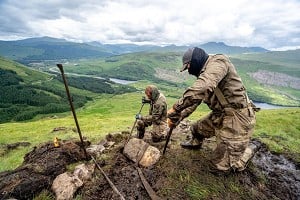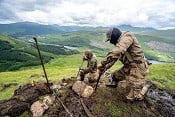
So I've got Hallus Limitus in both feet, pretty much progress to full Rigidus in my right big toe.
I can boulder and trad climb pretty much fine still, apart from the odd route where I need to stand on tiny footchips with no handholds which can be a problem.
Big mountain days are an issue though. I got out in the cold snap and got a mixed route on Clogwyn Du the other week. Nearly two weeks ago now, and both my toe joints are still burning.
I'm facing the decision to pack in winter climbing and big mountain walkins, and preserve my feet so I can keep focusing on trad and bouldering. I'm not sure it's worth just doing the odd week in Rjukan and select winter routes with limited walkins. With the weather these days it's not like you can't just boulder and trad climb most of the winter anyway.
Unless anyone can convince me there's something I can do to save/preserve my feet? Is it worth trying some different, lighter boots? I use Scarpa Mont Blanc Pros at the moment which are a good fit and don't hurt on the day while in the mountains, although I take ibuprofen routinely to temper the issues I also have from a few different knee injuries, so maybe it's being masked.
I suffer from Hallux Rigidus in my big toe and have been suffering in winter as well. I haven't done it yet, but I think my best solution would be to swap to the new style La Sportiva boots i.e. the ones with the Aequilibrium soles. For B3's I have been looking at the Gtech's or Summits (this is not a cheap option sadly) as having tried them on in shops the soles have a rocker/ergonmic shape. This means you can roll through the toe rather than try and bend it in a flat soled boot.
This is similar to advise for running with Halux Rigidus to buy shoes with good rocker to them. This means the toe doesn't have to bend in order to keep natural walking gate and may also help your knees. For me any other issue I have been having with hips ect all leads back to my Hallux Rigidus.
Obviously I may be completely wrong with this as am not a medical professional and haven't tried the boots in full and there are reports of the Gtechs not being as stiff which could cause more pain when front pointing.
Thanks, it is something I've considered, trying some lighter and more nimble boots.
I can manage walkins in approach shoes alright, six days on the trot in Morocco, although more climbing than walking in and out, and lighter packs.
Might have to try some GTechs next time I'm in outside..... but it's a hella expensive option if it turns out I'm just knackered and need to reign in my big days.
I have found the stiffer the boot the better, also use Superfeet carbon insoles which i find very comfy and supportive. I've also gone non dairy. This takes some time to kick in but toe is better this winter than most. For general walking etc I've been using Hoka speedgoats in a wide fit, these and the Superfeet have been a game changer for me.
I picked up some Superfeet Green this morning and did a 10k walk in my B0 boots and definitely an improvement but I'm still sat here with my toe joints hurting afterwards.
I'm non dairy anyway and have been for a while.
Heading north in a couple of weeks so will see how the insoles fare with some proper boots on a big mountain day.
I found the hoka Speedgoats great when I had a foot injury where I didn’t want to extend the big toe joint. I wear them for hill days now with seal skins - obviously not suitable for winter climbing. But idea of a decent rocker on the shoe sounds like it would help. I think you’re right about the brufen probably masking things. Could you try ice instead? I have a different foot problem to you but I think there are some ‘TLC’ things you could try. When I’m climbing I warm my foot up with some banded exercises which seems to really help increase blood flow. I stretch and foam roll my calves regularly as they got super tight from not extending my big toe for months. Toes joints are like all other synovial joints in that they like to move, so you could also try some mobilisation of the joints - rigidus allowing. You could also try using a massage tool on the sole of your foot and on the fleshy bits of the toes to break up any scar tissue. You might also find that ‘little and often’ helps build up the tolerance of your feet to loading, rather than doing a big day or week occasionally. Hope that helps.
At 37, After having big toe joint pain I had x-rays and the Dr told me I had early arthritis which he also called hallux rigidus. However he doesn't know what my baseline joint spacing is so was just his assessment.
Instead of protecting the joint I went down the route of trying to stretch and strengthen my toes feet and calves. I now wear bearfoot shoes, apart from when climbing and so far so good.








